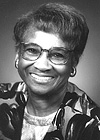Clarice Reid facts for kids
Quick facts for kids
Clarice Reid
|
|
|---|---|

Dr. Clarice Reid on her retirement from the National Heart, Lung, and Blood Institute (NHLBI), National Institutes of Health (NIH).
|
|
| Born |
Clarice D. Reid
1931 (age 93–94) |
| Alma mater |
|
| Known for |
|
| Scientific career | |
| Fields |
|
| Institutions | Jewish Hospital, Cincinnati Children's Hospital, Cincinnati |
Clarice D. Reid (born 1931) is an American doctor who specializes in treating children. This type of doctor is called a pediatrician. Dr. Reid was born in Birmingham, Alabama. She became a leader in the fight against Sickle Cell Disease. This is a serious blood condition. She led the National Sickle Cell Disease Program at the U.S. National Heart, Lung, and Blood Institute (NHLBI). This institute is part of the National Institutes of Health. Later, she became the Director of the Division of Blood Diseases and Resources at NHLBI. Dr. Reid also worked on a special group called the Taskforce on Black and Minority Health. She has even achieved a rare perfect score in the game of bridge!
Becoming a Doctor: Clarice Reid's Journey
Clarice Reid was born in Birmingham, Alabama in 1931. She went to a small elementary school. Then she attended the only high school for African American students in her city. Clarice decided to follow her father's path. She went to Talladega College in Alabama.
She first planned to become a medical technician. But she soon changed her mind. She wanted to be a doctor instead! She started medical school at Meharry Medical College in Nashville, Tennessee. Her husband found a job in Cincinnati. So, she finished her medical training there. She graduated from the University of Cincinnati College of Medicine. She was the third African American woman to earn an MD from that school. Dr. Reid is also a mother of four children. In 1970, she moved to the Washington, D.C. area.
Clarice Reid's Amazing Career
Dr. Reid completed her special training at Jewish Hospital and Children's Hospital Medical Center in Cincinnati. After that, she opened her own office. She worked as a pediatrician, helping many children. Later, she became the Director of Pediatric Education. She also led the Pediatric Department at Jewish Hospital.
After moving to the D.C. area, she joined a government health center. She worked as a medical consultant there. In 1973, she joined the National Sickle Cell Disease Program. This program is part of the National Heart, Lung, and Blood Institute.
Dr. Reid was part of an important group in 1985–86. It was called the Task Force on Black and Minority Health. This group looked at health issues for minority groups in the U.S. Their work led to the creation of the Office of Minority Health. In 1988, Dr. Reid retired. She had served the government for 26 years. She was the director of the Division of Blood Diseases and Resources (DBDR). She helped scientists work together. This led to big steps forward in understanding and treating sickle cell disease.
Awards and Special Honors
Dr. Clarice Reid has received many awards for her important work:
- Superior Service Award, the highest honor from the U.S. Public Health Service, 1989.
- NIH Director's Award.
- NIH MERIT Award.
- Two Public Health Service and Special Recognition Awards.
- The Presidential Meritorious Executive Rank Award, 1991.
- The Sickle Cell Disease Association of America (SCDAA) has a special lecture named after her. It is called the Clarice D. Reid, M.D. Lecture.
- She was recognized in the "NIH Women Making History" program.
- Black Enterprise magazine named her one of "America's Ten Leading Black Doctors."
- She was called a "Distinguished Woman" by the Black Women in Scholarship for Action.
- She is included in the book Book of Black Heroes, Volume II: Great Women in the Struggle. This book celebrates 84 amazing black women.

